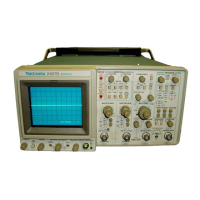Theory of Operation—2465B/2467B Service
will still be warm when power is restored. The output of
U4332A will still be near the voltage on U4366B pin 7
rather than starting over at zero volts as when the crt
cathode was
cold,
because the charge on C4430 dissi-
pates slowly during the power off time.
Z-AXIS DRIVE LEVEL. The variable-level Z-Axis signal
(VZ OUT) establishes the lower clamping level of the ac
waveform applied to the High Voltage Module. When the
negative peaks of the AC waveform are below the Z-Axis
signal level, CR4422 becomes forward biased, and the
negative ac waveform peaks are clamped at the Z-Axis
signal level. An image of the Z-axis signal can be seen in
the shaped ac waveform on Test Point 72. The VZ OUT
level may vary between +8 V and +75 V, depending on
the settings of the front-panel INTENSITY, READOUT
INTENSITY, Max Grid Drive controls, and Sweep mode.
The shaped ac waveform, now carrying both the
grid-
bias and the Z-Axis drive information, is applied to a DC
Restorer circuit in the High Voltage Module where it is
raised to the high-voltage levels of the crt cathode, and it
supplies the negative bias to the crt control-grid.
DC RESTORATION. The DC Restorer circuit in the
High Voltage Module is referenced to the crt cathode
voltage via a connection to pin 2 of U4310.
Capacitor C (in Figure 3-10), connected to pin 15 of
U4310,
initially charges to a level determined by the
difference between the Z-axis signal level (Test Point 72)
and the crt cathode potential through
R4421,
diode A, and
resistor E. Capacitor D is charged to a similar dc level
through resister F and R4419.
When the shaped ac waveform applied to pin 15 begins
its transition from the lower clamped level (set by the Z-
Axis signal) towards the upper clamped level (set by the
Grid Bias pot.), the charge on capacitor C increases
through diode A and resistor E. The additional charge is
proportional to the voltage difference between the two
clamped voltage levels.
The potential difference between the control grid and
the cathode controls the beam current and thus the
display intensity. With no Z-Axis signal applied (INTEN-
SITY control off), capacitor D will be charged to its max-
imum negative value, since the difference between the two
clamped voltage levels is at its maximum value. This is the
minimum intensity condition and reflects the setting of the
Grid Bias potentiometer. During calibration, the Grid Bias
pot is adjusted so that the difference between the upper
clamping level (set by the Grid Bias pot) and the "no
sig-
nal"
level of the Z-Axis drive signal (VZ OUT) produces a
control grid bias that barely shuts off the crt electron
beam.
As the INTENSITY control is advanced, the amplitude
of the square-wave Z-Axis signal increases accordingly.
This increased signal amplitude decreases the difference
between the upper and lower clamped levels of the ac
waveform. This decreases the potential difference between
the control grid and the cathode, and more crt beam
current is allowed to flow. Increased beam current
increases the crt display intensity.
The fast-rise and fast-fall transitions of the Z-Axis
sig-
nal are coupled to the crt control grid through capacitor D.
This ac-coupled fast-path signal quickly sends the crt elec-
tron beam to the new intensity level, then the slower DC
Restorer path through capacitor C "catches up" to handle
the DC and low-frequency components of the Z-Axis drive
signal.
Anode Current Limiter and Multiplier
The Anode Current Limiter keeps maximum Intensity to
a comfortable viewing level. It also protects the Micro
Channel Plate element from excessive aging. The anode
multiplier provides the CRT with the necessary high volt-
age accelerating potential.
ANODE CURRENT LIMITER. The maximum anode
current is limited to a safe value during high intensity drive
conditions by increasing the crt control-grid DC bias. This
increased grid bias reduces the cathode current which
limits the maximum number of electrons arriving at the
MCP,
the Anode, and the CRT screen.
The circuit is composed of Q4300 and Q4301 and asso-
ciated circuitry to form a comparator which increases crt
grid bias at high intensity settings, and also limits max-
imum intensity.
Q4301 is biased at —5 V and is off at low to medium
crt intensity settings. Peak anode current is sampled and
averaged across R4300 and C4300. Darlington Emitter
Follower Q4300 is configured as a voltage follower to
current converter. The voltage difference between emitter
of Q4300 and emitter Q4301 is converted to current
through R4304. At low crt intensity settings the base of
Q4300 is near zero and the emitter is about —1.5 volts.
Therefore, all current flowing through R4306 flows through
Q4300.
During high intensity drive conditions CRT anode
current produces an average voltage greater than —4.4
Volts across R4300, C4300 and the base of Q4300. When
the emitter is greater than about -5.8 volts, part of the
current flowing in Q4300 starts flowing through R4304 and
into emitter of
Q4301.
The increasing collector current
through Q4301 goes into the base node of inverting opera-
tional amplifier Q4331 and raises the grid bias clamping
voltage on the collector of
Q4331.
This increasing clamp-
ing voltage increases the CRT grid bias until the anode
current is limited. Operation of crt grid biasing is explained
in detail in Grid Bias Level.
3a-44

